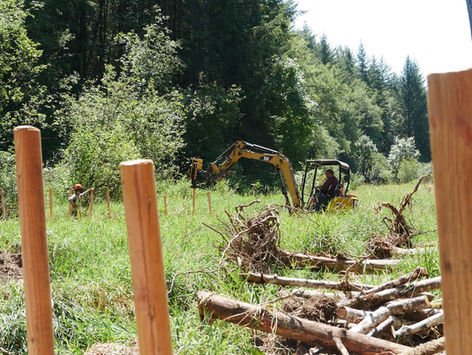
East Fork of the Lewis River: Mason Creek Restoration
About
This project will enhance 2.5 miles of aquatic habitat and riparian communities along upper Mason Creek, a tributary of the East Fork Lewis River. We will install 250 instream habitat structures (Post Assisted Log Structures -PALs and Beaver Dam Analogs -BDAs) and 27,000 riparian plants. These actions will increase in-stream habitat complexity, floodplain connectivity, riparian function, groundwater recharge, channel aggradation, habitat complexity, and wood retention. The primary species benefiting include Fall Chinook, Winter and Summer Steelhead, Coho, and Chum; the secondary species include Pacific Lamprey, Cutthroat Trout, as well as numerous others. Mason Creek is considered one of the more productive salmon tributaries in this region. However, it currently struggles with a tendency to run dry during the summer months, which often leads to fish strandings. Our design for this project focuses on riparian plantings and installing structures designed to slow flows and hold water on the landscape. We hope that these efforts will be sufficient to restore year-round flow in addition to the other benefits listed.
The Mason Creek watershed supports populations of Chinook, Winter and Summer Steelhead, Coho, Chum, Pacific Lamprey, and Cutthroat Trout, which are limited by degraded spawning and rearing habitat conditions. This is due to a variety of factors, but most notably the historic removal of instream and riparian wood and trees, loss of willow communities due to timber herbicide runoff, the trapping of beaver, and invasive non-native riparian plants (primarily reed canary grass). These factors limit instream complexity, frequency of overbank flow/floodplain connectivity, and health of riparian areas, all of which limit production and productivity for the impacted populations. These factors have also accelerated the drainage efficiency of the system, exacerbating low summer flows and the likelihood for the creek to run dry during the summer. For all species, the increasing seasonality of the creek is a huge limiting factor. This area was well known as a prolific beaver region and contained several extensive beaver complexes spanning several miles. These areas stored enormous volumes of water and provided essential rearing habitat for juvenile salmonids. The dams protected spawning gravel downstream by retaining fine sediments, which made perfect spawning habitats behind the dams for pacific lamprey. The lamprey ammocoetes, in turn, served as a key food supply for the salmonids. Today these beaver ponds are largely abandoned due to a loss of willow and possible trapping. However, they persist as some of the only areas that remain wet during peak droughts despite massive reductions in storage capacity. While other changes in land use practices have undoubtedly played a role in the creek’s shift in seasonality, the loss of beaver was likely a major contributor. Outside of the beaver areas, the creek struggles with structural starvation, channel incision, floodplain disconnection, and simplified riparian habitats. This project will address these limiting factors by increasing in-stream structure and habitat complexity, restoring the beaver ponds, management of invasive reed canary grass, and enhancement of riparian communities. These actions will improve sediment sorting, increase habitat complexity with greater pool and bar frequency, increase floodplain and side channel connectivity, expand juvenile rearing habitat, and improve spawning habitat.
Summer 2025 Update

We are busy beavers at Mason Creek!
During the summer of 2025, LCFEG was hard at work enhancing Mason Creek with beaver dam analogs (BDAs) and post-assisted log structures to increase habitat complexity and reconnect the creek to its natural floodplain. These features imitate the work of real beavers, slowing water, creating side channels, and improving habitat for salmon and a variety of other wildlife.
We’re joined by the Washington State Department of Ecology’s Youth Conservation Corps, whose team is lending a hand with BDA construction and other on-the-ground needs.
By the time the 2025 season wraps up, over 100 new structures will be in place across the project site. Come fall, we’ll begin removing the temporary access road and launching our revegetation efforts to restore native plant communities.
Mason Creek Moments
Target Species
Metrics

Partners | Consultants
Contractors
Funds
Chinook, Winter and Summer Steelhead, Coho, Chum, Pacific Lamprey, and Cutthroat Trout
2.5 Miles of Stream Treated, 250 Habitat Structures Placed, and 27,000 Native Plants Installed
Clark Conservation District, Washington Youth Conservation Corps
WA State Recreation and Conservation Office: Salmon Recovery Funding Board
(23-1155) $272,346.00
















